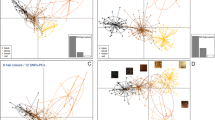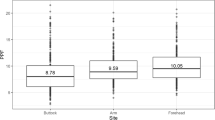Abstract
Variation in facial hair is one of the most conspicuous features of facial appearance, particularly in South Asia and Middle East countries. A genome-wide association study in Latin Americans has identified multiple genetic variants at distinct loci being associated with facial hair traits including eyebrow thickness, beard thickness, and monobrow. In this pilot study, we have evaluated 16 SNPs associated with facial hair traits in 58 male individuals from the Punjabi population of Pakistan. In our sample, rs365060 in EDAR and rs12597422 in FTO showed significant association with monobrow, rs6684877 in MACF1 showed significant association with eyebrow thickness, and two SNPs in LOC105379031 (rs9654415 and rs7702331) showed significant association with beard thickness. Our results also suggest that genetic association may vary between ethnic groups and geographic regions. Although more data are needed to validate our results, our findings are of value in forensic molecular photofitting research in Pakistan.
Similar content being viewed by others
References
Du QQ, Lu CL, Cong B, Li SJ. Research progress on forensic genetics of facial morphological depiction. Fa Yi Xue Za Zhi. 2019;35(5):531–6.
Marcińska M, Pośpiech E, Abidi S, Andersen JD, Van Den Berge M, Carracedo Á, Eduardoff M, Marczakiewicz-Lustig A, Morling N, Sijen T, Skowron M. Evaluation of DNA variants associated with androgenetic alopecia and their potential to predict male pattern baldness. PLoS One. 2015:22;10(5):e0127852.
Keating B, Bansal AT, Walsh S, Millman J, Newman J, Kidd K, Budowle B, Eisenberg A, Donfack J, Gasparini P, Budimlija Z. First all-in-one diagnostic tool for DNA intelligence: genome-wide inference of biogeographic ancestry, appearance, relatedness, and sex with the Identitas v1 Forensic Chip. Int J Legal Med. 2013;127(3):559–72.
Gurkan C, Bulbul O, Kidd KK. Current and emerging trends in human identification and molecular anthropology. Front Genet. 2021:1041.
Beseris EA, Naleway SE, Carrier DR. Impact protection potential of mammalian hair: testing the pugilism hypothesis for the evolution of human facial hair. Integr Org Biol. 2020;2(1):obaa005.
Adhikari K, Fontanil T, Cal S, Mendoza-Revilla J, Fuentes-Guajardo M, Chacón-Duque J-C, et al. A genome-wide association scan in admixed Latin Americans identifies loci influencing facial and scalp hair features. Nat Commun. 2016;7:10815.
The International HapMap Consortium. The International HapMap Project. Nature. 2003;426:789–96.
Spudich GM, Fernández-Suárez XM. Touring Ensembl: a practical guide to genome browsing. BMC Genomics. 2010;11:295.
Marshall OJ. PerlPrimer: cross-platform, graphical primer design for standard, bisulphite and real-time PCR. Bioinformatics. 2004;20:2471–2.
Podini D. PM Vallone. SNP genotyping using multiplex single base primer extension assays. In Single Nucleotide Polymorphisms: Methods and Protocols; Komar, A.A., Ed.; Humana Press: Totowa, NJ, USA. 2009;379–391.
Rodriguez S, Gaunt TR, Day IN. Hardy-Weinberg equilibrium testing of biological ascertainment for Mendelian randomization studies. Am J Epidemiol. 2009;169:505–14.
Liu F, van der Lijn F, Schurmann C, Zhu G, Chakravarty MM, Hysi PG, et al. A genome-wide association study identifies five loci influencing facial morphology in Europeans. Gibson G, editor. PLoS Genet. 2012;8:e1002932.
Forensic DNA phenotyping. predicting human appearance from crime scene material for investigative purposes. Forensic Sci Int Genet. 2015;18:33–48.
Phillips C. Forensic genetic analysis of bio-geographical ancestry. Forensic Sci Int Genet. 2015;18:49–65.
Pulker H, Lareu MV, Phillips C, Carracedo A. Finding genes that underlie physical traits of forensic interest using genetic tools. Forensic Sci Int Genet. 2007;1:100–4.
Butler K, Peck M, Hart J, Schanfield M, Podini D. Molecular, “eyewitness”: forensic prediction of phenotype and ancestry. Forensic Sci Int Genet Suppl Ser. 2011;3:e498–9.
Carvalho CMB, Pena SDJ. Optimization of a multiplex minisequencing protocol for population studies and medical genetics. Genet Mol Res GMR. 2005;4:115–25.
Esteves LM, Bulhões SM, Brilhante MJ, Mota-Vieira L. Three multiplex snapshot assays for SNP genotyping in candidate innate immune genes. BMC Res Notes. 2013;6:54.
Hardy GH. Mendelian proportions in a mixed population. Science. 1908;28:49–50.
Butler JM, Decker AE, Kline MC, Vallone PM. Chromosomal duplications along the Y-chromosome and their potential impact on Y-STR interpretation. J Forensic Sci. 2005;50:853–9.
Cox DG, Kraft P. Quantification of the power of Hardy-Weinberg equilibrium testing to detect genotyping error. Hum Hered. 2006;61:10–4.
Pośpiech E, Karłowska-Pik J, Kukla-Bartoszek M, Woźniak A, Boroń M, Zubańska M, Jarosz A, Bronikowska A, Grzybowski T, Płoski R, Spólnicka M. Overlapping association signals in the genetics of hair-related phenotypes in humans and their relevance to predictive DNA analysis. Forensic Sci Int Genet. 2022;1(59): 102693.
Mok KW, Saxena N, Heitman N, Grisanti L, Srivastava D, Muraro MJ, Jacob T, Sennett R, Wang Z, Su Y, Yang LM. Dermal condensate niche fate specification occurs prior to formation and is placode progenitor dependent. Dev Cell. 2019;48(1):32–48.
Baumeister FA, Egger J, Schildhauer MT, Stengel-Rutkowski S. Ambras syndrome: delineation of a unique hypertrichosis universalis congenita and association with a balanced pericentric inversion. Clin Genet. 1993;44:121–8.
Miller JD, McKusick VA, Malvaux P, Temtamy S, Salinas C. The 3-M syndrome: a heritable low birthweight dwarfism. Birth Defects Orig Artic Ser. 1975;11(5):39–47.
HabibUllah H, Albaradie R, Bashir S. 3-M syndrome: a local case report. The American Journal of Case Reports. 2019;20:36.
Urschel Jr HC. Poland syndrome. Seminars in thoracic and cardiovascular surgery. WB Saunders. 2009;21:89–94).
Henningsen E, Svendsen MT, Lildballe DL, Jensen PK. A novel mutation in the EDAR gene causes severe autosomal recessive hypohidrotic ectodermal dysplasia. Am J Med Genet A. 2014;164:2059–61.
Acknowledgements
We thank all volunteers who provided material and data for this project.
Funding
This study was financially supported by University of Health Sciences Lahore, Pakistan.
Author information
Authors and Affiliations
Contributions
A.R., A.A., and M.J. designed this study. M.J. and S.N. collected the samples. M.J., S.N., and A.A. conducted the experiment. A.A., A.R., M.J., SAM.A, S.H., OA.A., C.C.W, and F.L. analyzed the results. M.J. wrote the initial manuscript. A.A. and F.L. completed and modified the manuscript. All authors critically reviewed the manuscript and provided approval of the version to be published.
Corresponding authors
Ethics declarations
Informed consent and ethical approval
All participants gave their informed consent either orally (in case they could not write) or in writing after the study aims and procedures were carefully explained to them. The study was approved by the ethical review committee of the University of Health Sciences, Lahore, Punjab, Pakistan, and in accordance with the standards of the Declaration of Helsinki 1964.
Competing interests
The authors declare no competing interests.
Additional information
Publisher's Note
Springer Nature remains neutral with regard to jurisdictional claims in published maps and institutional affiliations.
Supplementary Information
Below is the link to the electronic supplementary material.
Rights and permissions
Springer Nature or its licensor holds exclusive rights to this article under a publishing agreement with the author(s) or other rightsholder(s); author self-archiving of the accepted manuscript version of this article is solely governed by the terms of such publishing agreement and applicable law.
About this article
Cite this article
Jawad, M., Adnan, A., Rehman, R.A. et al. Evaluation of facial hair-associated SNPs: a pilot study on male Pakistani Punjabi population. Forensic Sci Med Pathol 19, 293–302 (2023). https://doi.org/10.1007/s12024-022-00515-z
Accepted:
Published:
Issue Date:
DOI: https://doi.org/10.1007/s12024-022-00515-z




